Evolution of The Ship Excursion - Part IV
By Don Dressel
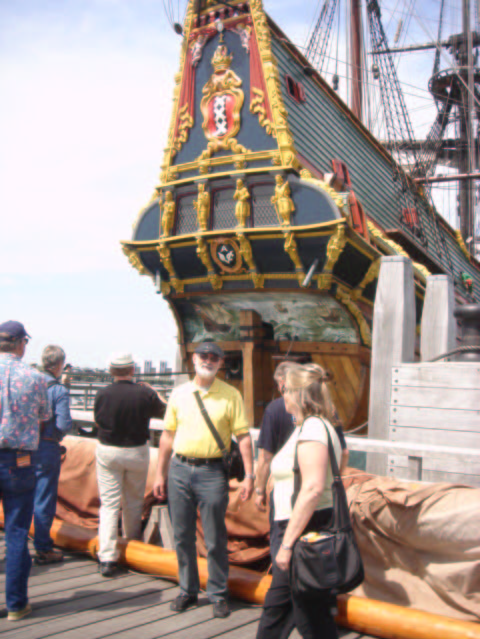 Now
we are on our way to Amsterdam in the Netherlands. The first stop
was the Batavia Werf, were we visited the BATAVIA and De Ruyter’s
famous ZEVEN PROVINCIEN, which was only in frame. My wife and I and
already seen BATAVIA in
Now
we are on our way to Amsterdam in the Netherlands. The first stop
was the Batavia Werf, were we visited the BATAVIA and De Ruyter’s
famous ZEVEN PROVINCIEN, which was only in frame. My wife and I and
already seen BATAVIA in
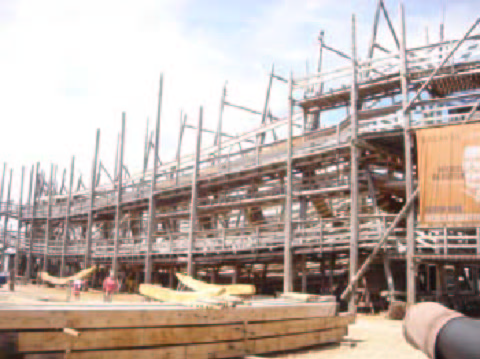 Australia
when the Olympics were there, so this was an added treat. We got to
climb all over the BATAVIA, but not the ZEVEN PROVINCIEN. Note the
typical painting on the stern of the ship which Sid Siegel was so
good at. The BATAVIA is built like the real thing – there are no
modern items added to the ship. For that reason, she cannot sail
with people aboard. It was about as real as you can get. There were
also many fine models of Dutch ships in the Batavia Werf’s Museum,
which for space reasons, cannot be included in this little article.
Here’s hoping that more money can be raised to complete the ZEVEN
PROVINCIEN.
Australia
when the Olympics were there, so this was an added treat. We got to
climb all over the BATAVIA, but not the ZEVEN PROVINCIEN. Note the
typical painting on the stern of the ship which Sid Siegel was so
good at. The BATAVIA is built like the real thing – there are no
modern items added to the ship. For that reason, she cannot sail
with people aboard. It was about as real as you can get. There were
also many fine models of Dutch ships in the Batavia Werf’s Museum,
which for space reasons, cannot be included in this little article.
Here’s hoping that more money can be raised to complete the ZEVEN
PROVINCIEN.
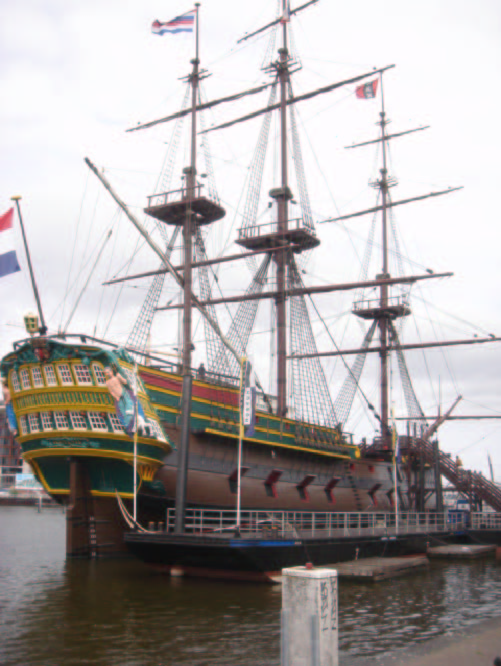 The
next day we took a tour of the city of Amsterdam, then had time to
visit the historic Anne Frank house and the Van Gogh Museum, along
with the quaint canals and gabled houses of this famous city. In the
evening, which was Day 13 of the trip, we had a farewell dinner for
those who were leaving the tour at this point. Just before the
dinner, we visited the AMSTERDAM, a full-scale replica of a 17th
century Dutch East Indiaman.
The
next day we took a tour of the city of Amsterdam, then had time to
visit the historic Anne Frank house and the Van Gogh Museum, along
with the quaint canals and gabled houses of this famous city. In the
evening, which was Day 13 of the trip, we had a farewell dinner for
those who were leaving the tour at this point. Just before the
dinner, we visited the AMSTERDAM, a full-scale replica of a 17th
century Dutch East Indiaman.
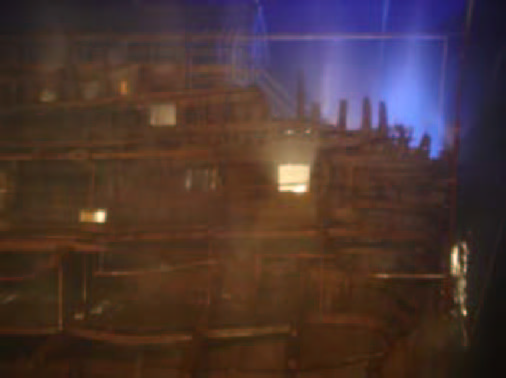 For
those continuing the tour (which included my wife and I), a train
trip was scheduled via Brussels for Day 14 going to London, England
(we went underneath the British Channel on the STAR train). We only
spent a short time in London, as our destination was Portsmouth.
While in Portsmouth, we visited the Royal Dockyard Museum which
houses many models and the HMS VICTORY, HMS ROSE and HMS WARRIOR. I
will not go into detail on
For
those continuing the tour (which included my wife and I), a train
trip was scheduled via Brussels for Day 14 going to London, England
(we went underneath the British Channel on the STAR train). We only
spent a short time in London, as our destination was Portsmouth.
While in Portsmouth, we visited the Royal Dockyard Museum which
houses many models and the HMS VICTORY, HMS ROSE and HMS WARRIOR. I
will not go into detail on
these three famous ships, but, as a ship lover and modeler, you will
really have a great day at this museum. You can climb all over the
HMS VICTORY, see the HMS MARY ROSE (what is left of her, although
they are still spraying her with preservative solution, but you can
see quite a bit), and take tours of the HMS WARRIOR in addition to
the museums and shops that are there. A full
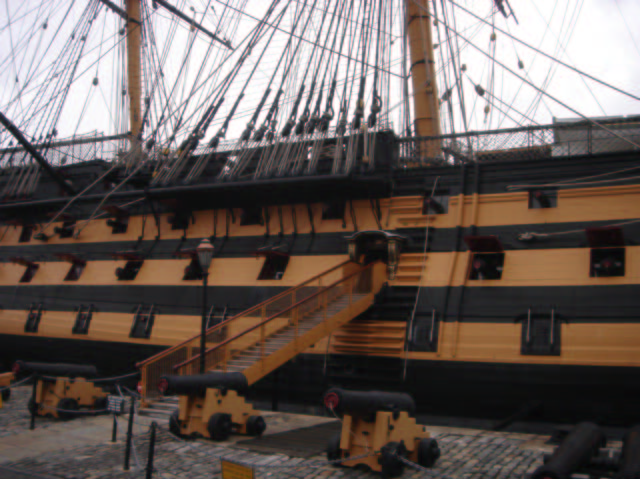 and
enjoyable day! There were many models in the various museums (there
were three, one for each of the ships present), and a number of
wonderful diorama’s showing how things were done then. You could
spend as much time in the museums as you could inspecting the ships
The MARY ROSE, c 1514, was a great carrack and capital ship of Henry
VII which capsized off Portsmouth in battle when trying to fend off
a French invasion in 1545. This magnificent vessel combined several
types and eras of ship construction. Artifacts preserved from the
wreck present a complex picture of late medieval naval warfare and
seafaring life.
and
enjoyable day! There were many models in the various museums (there
were three, one for each of the ships present), and a number of
wonderful diorama’s showing how things were done then. You could
spend as much time in the museums as you could inspecting the ships
The MARY ROSE, c 1514, was a great carrack and capital ship of Henry
VII which capsized off Portsmouth in battle when trying to fend off
a French invasion in 1545. This magnificent vessel combined several
types and eras of ship construction. Artifacts preserved from the
wreck present a complex picture of late medieval naval warfare and
seafaring life.
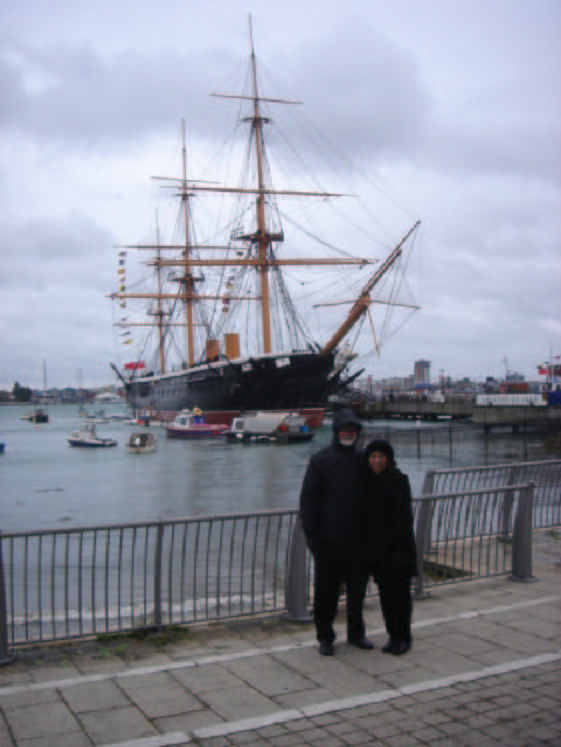
HMS VICTORY, 1557, 1757, was Admiral Nelson’s flagship at the Battle
of Trafalgar. The VICTORY is not only the most famous
ship-of-the-line from the climactic battle of the age of sail and
the sole surviving three-decker man-of-war, but is representative of
the penultimate sailing machines which determined the course of
empire from the time of the Spanish ironclad.
HMS WARRIOR, 1861, was the first modern battleship. A contemporary
of Star of India, WARRIOR revolutionized the nature of naval
warfare, establishing a dynasty of naval technology that reached its
apogee at the battle of Jutland in 1915.
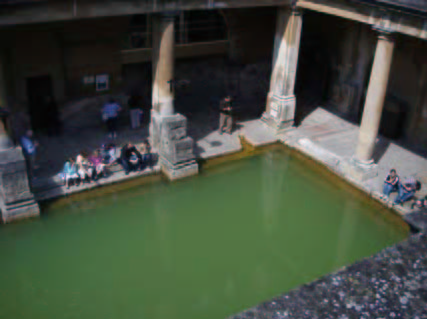 We
then went from Portsmouth to Bristol, visiting on the way the
magnificent church at Salisbury, Stonehenge, and the City of Bath,
were the Roman built a magnificent temple and bathing complex that
still flows with natural hot water around Britain’s only hot spring.
We
then went from Portsmouth to Bristol, visiting on the way the
magnificent church at Salisbury, Stonehenge, and the City of Bath,
were the Roman built a magnificent temple and bathing complex that
still flows with natural hot water around Britain’s only hot spring.
SALISBURY is unique amongst medieval English cathedrals, built
within on century with no substantial later additions. She also
houses one of the oldest clocks in the world, and tours are
conducted to see the interior of the cathedral and the many
monuments to the people who were buried there, most of whom were
royalty. It was also interesting to see the model they had of the
cathedral under construction.
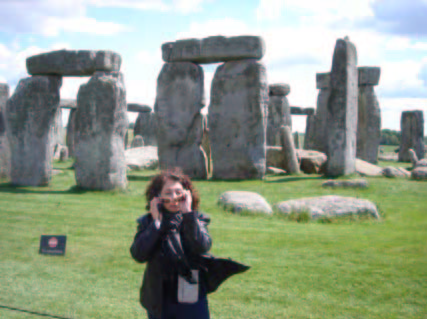 The next stop made was at Stonehenge, which stands, seemingly alone,
in the midst of a great tract of Salisbury Plain. The origins of
Stonehenge lie in the middle Neolithic Age of around 2900 BC, while
the famous stones were erected and being used between 2550 and 1600
BC. It was a mysterious place to visit and made one think of the
ancient people who once inhabited this region.
The next stop made was at Stonehenge, which stands, seemingly alone,
in the midst of a great tract of Salisbury Plain. The origins of
Stonehenge lie in the middle Neolithic Age of around 2900 BC, while
the famous stones were erected and being used between 2550 and 1600
BC. It was a mysterious place to visit and made one think of the
ancient people who once inhabited this region.
Then, we visited the city of BATH which is famous for the hot
springs, the only ones in Britain. The Romans built a magnificent
temple and bathing complex that still flows with natural hot water.
It was also a fashionable social center for Georgian life for
flirting, flaunting, gossiping, gambling, and “taking the waters”.
Not all the trip was spent visiting ships.
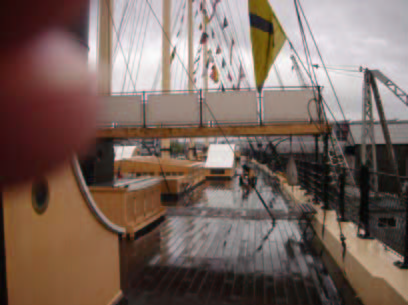 On Wednesday, May 30, we visited the last ship, the SS GREAT BRITIAN
of 1842. She is the first modern steam ship and one of four
surviving to have carried emigrants under sail (during at time in
her life she was a pure sailing ship). This masterpiece of mid-19th
century technology was the greatest success of that century’s
greatest engineer, Isembard Kingdom Brunel. She was a contemporary
of the STAR OF INDIA and the technological source point of the steam
powered merchantman.
On Wednesday, May 30, we visited the last ship, the SS GREAT BRITIAN
of 1842. She is the first modern steam ship and one of four
surviving to have carried emigrants under sail (during at time in
her life she was a pure sailing ship). This masterpiece of mid-19th
century technology was the greatest success of that century’s
greatest engineer, Isembard Kingdom Brunel. She was a contemporary
of the STAR OF INDIA and the technological source point of the steam
powered merchantman.
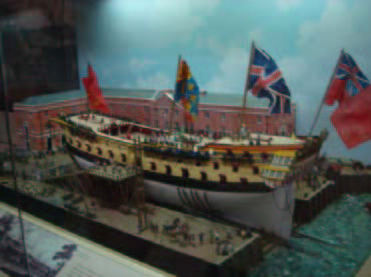
Unfortunately, all good things must come to an end, and so the trip
was concluded with this trip to the SS GREAT BRITIAN. After an early
breakfast, we transferred to London, were we caught our flight back
home. Many more pictures were taken, especially of the many
beautiful models seen at the various museums. Perhaps one day a
presentation to the club can be arranged, if so desired. Comments
would be appreciated by the membership. Thus concludes this short
dissertation on a great trip. Now
we are on our way to Amsterdam in the Netherlands. The first stop
was the Batavia Werf, were we visited the BATAVIA and De Ruyter’s
famous ZEVEN PROVINCIEN, which was only in frame. My wife and I and
already seen BATAVIA in
Now
we are on our way to Amsterdam in the Netherlands. The first stop
was the Batavia Werf, were we visited the BATAVIA and De Ruyter’s
famous ZEVEN PROVINCIEN, which was only in frame. My wife and I and
already seen BATAVIA in
 Australia
when the Olympics were there, so this was an added treat. We got to
climb all over the BATAVIA, but not the ZEVEN PROVINCIEN. Note the
typical painting on the stern of the ship which Sid Siegel was so
good at. The BATAVIA is built like the real thing – there are no
modern items added to the ship. For that reason, she cannot sail
with people aboard. It was about as real as you can get. There were
also many fine models of Dutch ships in the Batavia Werf’s Museum,
which for space reasons, cannot be included in this little article.
Here’s hoping that more money can be raised to complete the ZEVEN
PROVINCIEN.
Australia
when the Olympics were there, so this was an added treat. We got to
climb all over the BATAVIA, but not the ZEVEN PROVINCIEN. Note the
typical painting on the stern of the ship which Sid Siegel was so
good at. The BATAVIA is built like the real thing – there are no
modern items added to the ship. For that reason, she cannot sail
with people aboard. It was about as real as you can get. There were
also many fine models of Dutch ships in the Batavia Werf’s Museum,
which for space reasons, cannot be included in this little article.
Here’s hoping that more money can be raised to complete the ZEVEN
PROVINCIEN.  The
next day we took a tour of the city of Amsterdam, then had time to
visit the historic Anne Frank house and the Van Gogh Museum, along
with the quaint canals and gabled houses of this famous city. In the
evening, which was Day 13 of the trip, we had a farewell dinner for
those who were leaving the tour at this point. Just before the
dinner, we visited the AMSTERDAM, a full-scale replica of a 17th
century Dutch East Indiaman.
The
next day we took a tour of the city of Amsterdam, then had time to
visit the historic Anne Frank house and the Van Gogh Museum, along
with the quaint canals and gabled houses of this famous city. In the
evening, which was Day 13 of the trip, we had a farewell dinner for
those who were leaving the tour at this point. Just before the
dinner, we visited the AMSTERDAM, a full-scale replica of a 17th
century Dutch East Indiaman.
 For
those continuing the tour (which included my wife and I), a train
trip was scheduled via Brussels for Day 14 going to London, England
(we went underneath the British Channel on the STAR train). We only
spent a short time in London, as our destination was Portsmouth.
While in Portsmouth, we visited the Royal Dockyard Museum which
houses many models and the HMS VICTORY, HMS ROSE and HMS WARRIOR. I
will not go into detail on
For
those continuing the tour (which included my wife and I), a train
trip was scheduled via Brussels for Day 14 going to London, England
(we went underneath the British Channel on the STAR train). We only
spent a short time in London, as our destination was Portsmouth.
While in Portsmouth, we visited the Royal Dockyard Museum which
houses many models and the HMS VICTORY, HMS ROSE and HMS WARRIOR. I
will not go into detail on  and
enjoyable day! There were many models in the various museums (there
were three, one for each of the ships present), and a number of
wonderful diorama’s showing how things were done then. You could
spend as much time in the museums as you could inspecting the ships
The MARY ROSE, c 1514, was a great carrack and capital ship of Henry
VII which capsized off Portsmouth in battle when trying to fend off
a French invasion in 1545. This magnificent vessel combined several
types and eras of ship construction. Artifacts preserved from the
wreck present a complex picture of late medieval naval warfare and
seafaring life.
and
enjoyable day! There were many models in the various museums (there
were three, one for each of the ships present), and a number of
wonderful diorama’s showing how things were done then. You could
spend as much time in the museums as you could inspecting the ships
The MARY ROSE, c 1514, was a great carrack and capital ship of Henry
VII which capsized off Portsmouth in battle when trying to fend off
a French invasion in 1545. This magnificent vessel combined several
types and eras of ship construction. Artifacts preserved from the
wreck present a complex picture of late medieval naval warfare and
seafaring life. 
 We
then went from Portsmouth to Bristol, visiting on the way the
magnificent church at Salisbury, Stonehenge, and the City of Bath,
were the Roman built a magnificent temple and bathing complex that
still flows with natural hot water around Britain’s only hot spring.
We
then went from Portsmouth to Bristol, visiting on the way the
magnificent church at Salisbury, Stonehenge, and the City of Bath,
were the Roman built a magnificent temple and bathing complex that
still flows with natural hot water around Britain’s only hot spring. The next stop made was at Stonehenge, which stands, seemingly alone,
in the midst of a great tract of Salisbury Plain. The origins of
Stonehenge lie in the middle Neolithic Age of around 2900 BC, while
the famous stones were erected and being used between 2550 and 1600
BC. It was a mysterious place to visit and made one think of the
ancient people who once inhabited this region.
The next stop made was at Stonehenge, which stands, seemingly alone,
in the midst of a great tract of Salisbury Plain. The origins of
Stonehenge lie in the middle Neolithic Age of around 2900 BC, while
the famous stones were erected and being used between 2550 and 1600
BC. It was a mysterious place to visit and made one think of the
ancient people who once inhabited this region.  On Wednesday, May 30, we visited the last ship, the SS GREAT BRITIAN
of 1842. She is the first modern steam ship and one of four
surviving to have carried emigrants under sail (during at time in
her life she was a pure sailing ship). This masterpiece of mid-19th
century technology was the greatest success of that century’s
greatest engineer, Isembard Kingdom Brunel. She was a contemporary
of the STAR OF INDIA and the technological source point of the steam
powered merchantman.
On Wednesday, May 30, we visited the last ship, the SS GREAT BRITIAN
of 1842. She is the first modern steam ship and one of four
surviving to have carried emigrants under sail (during at time in
her life she was a pure sailing ship). This masterpiece of mid-19th
century technology was the greatest success of that century’s
greatest engineer, Isembard Kingdom Brunel. She was a contemporary
of the STAR OF INDIA and the technological source point of the steam
powered merchantman. 